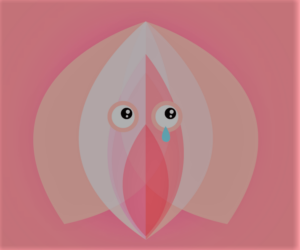 Vulvodynia is an alarm from the body, a sign something needs to be addressed. Once the fire is extinguished, vulvodynia can go away for good. In the search of a cure for vulvodynia and going from specialist to specialist, we often hear that there is “no cure”: But let’s clarify that. When in Western Medicine we speak of a lack of cure, it means there isn’t a remedy that can be given to you to “fix” the problem. However, we just need to change the approach on how we understand health and the body, because vulvodynia is not an illness to be cured, vulvodynia is a symptom. For this reason, when the underlying causes are solved, vulvodynia can go away permanently. Vulvodynia simply means “vulvar pain”, however, in order to release the symptom, we need to address the underlying causes. While I cannot speak for your specific case or illnesses that may be causing it, there are generally some underlying factors that are at the root of that pain. For this reason, we don’t “cure” vulvodynia, what we do is bring the body back to health, so it can heal itself. So if we heal our body, the alarm doesn’t need to go off anymore, and vulvodynia can leave to never come back. Yes, it may be a more sensitive area for you, women with vulvodynia tend to have pretty sensitive skin in general, however, there is no need to have this pain once the body is in balance.
Vulvodynia is an alarm from the body, a sign something needs to be addressed. Once the fire is extinguished, vulvodynia can go away for good. In the search of a cure for vulvodynia and going from specialist to specialist, we often hear that there is “no cure”: But let’s clarify that. When in Western Medicine we speak of a lack of cure, it means there isn’t a remedy that can be given to you to “fix” the problem. However, we just need to change the approach on how we understand health and the body, because vulvodynia is not an illness to be cured, vulvodynia is a symptom. For this reason, when the underlying causes are solved, vulvodynia can go away permanently. Vulvodynia simply means “vulvar pain”, however, in order to release the symptom, we need to address the underlying causes. While I cannot speak for your specific case or illnesses that may be causing it, there are generally some underlying factors that are at the root of that pain. For this reason, we don’t “cure” vulvodynia, what we do is bring the body back to health, so it can heal itself. So if we heal our body, the alarm doesn’t need to go off anymore, and vulvodynia can leave to never come back. Yes, it may be a more sensitive area for you, women with vulvodynia tend to have pretty sensitive skin in general, however, there is no need to have this pain once the body is in balance.
Vulvodynia can go away permanently
Our bodies are prepared for healing, they do that with acute wounds all the time. When it comes to chronic conditions, there are several aspects that need to be addressed, but under the right conditions, the body has the innate ability to heal. I am going to share with you some of the main systems to address in order to bring the body back to homeostasis (balance). This is what I did, and this is how I healed, by going deep into the root, my body could flourish.
Pain Is Created in the Brain
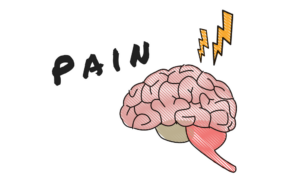 Pain is created in the brain, so the nervous system is a big piece of the equation to be able to heal. We need to create a parasympathetic state (rest, digest, and repair) to have an environment where healing can happen. As you see, this (apparently) has nothing to do with the vulva directly, and that’s why many treatments oriented to just treating the pelvic floor region, aren’t sufficient. However, if there is no organic disease that explains the pain, we need to look beyond. So even though the pain is felt “down there”, we first need to dig “up there” to fully address the pain.
Pain is created in the brain, so the nervous system is a big piece of the equation to be able to heal. We need to create a parasympathetic state (rest, digest, and repair) to have an environment where healing can happen. As you see, this (apparently) has nothing to do with the vulva directly, and that’s why many treatments oriented to just treating the pelvic floor region, aren’t sufficient. However, if there is no organic disease that explains the pain, we need to look beyond. So even though the pain is felt “down there”, we first need to dig “up there” to fully address the pain.
On one hand, when there is dysregulation of the nervous system, it is difficult to regulate it “cognitively”, we need to address the body in order for the nervous system to calm down. We need to work with a somatic approach to release the emotions stored in the body and facilitate the improvement of the nervous system. On the other hand, it is also important to address the psychological underlying causes, as psychosocial challenges are a very significant finding among women with vulvodynia. While there are many cases of sexual trauma, or shame around sexuality, it won’t always necessarily be like that. Women tend to store a lot of their fear in their pelvic floor, so even if it is not related to sexuality, your emotions trapped in the body are dysregulating your nervous system. It is a little more complex than this, however, to not get into deep details on the neuroendocrinology of it, just know that it is very likely that work at an emotional level needs to be done. Many times, this includes addressing your surroundings, your beliefs, the interactions with the people around you, your ability to set boundaries, the relationships that serve you or that drain you in your life. After all, you cannot heal in the same environment that made you sick. Vulvodynia could come and go if you don’t make the necessary changes it is pointing you to do, that’s why I don’t “cure” the pain but approach the person as a whole: so you can fully heal, not only your body, but everything around you.
Proprioception: muscles, fascia, and brain
To contribute to this regulation of the body, it is very important to address proprioception, so basically how your body senses itself. While myofascial work also helps to improve biomechanics (we will see more on this later), it is important to know that the proprioceptive signals (that inform the brain about the body’s movement and position) travel through the same pathways as the nociceptive (pain) signals. When we increase proprioception, we override nociception, therefore we help tone down the pain signal.
While there are several ways to increase proprioception, I have found that myofascial release is a very useful one because it attunes us to our body, helps our nervous system rewire, and at the same time, it liberates tension from the body. Many things we do daily, increase tension patterns in the body: The way you sit, how much you sit, the way you move, how much you move, how you carry your body, your alignment… and all of this, which we do unknowingly, make a big difference in the amount of pressure that we hold into our bodies, into our pelvic area, and therefore, the pressure that will go onto our pelvic organs – which at the same time, create more pressure on the nerves. When we release some of the tension, our body can move more freely. They can work better and receive the nutrients that they need, which in result affects pain levels.
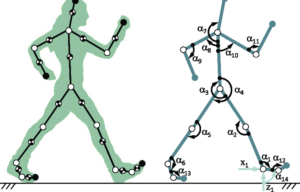
Biomechanics: How we use our body
In general, we tend to have poor posture and movement, we don’t tend to walk or sit in the optimal positions, nor do we move as much as we would need, but that’s not all. While our mostly sedentary lifestyle or being on our feet for hours affects our bodies, this is also tied to what I was mentioning before with the emotions. When there’s fear, and most chronic pain sufferers feel a level of unsafety, whether they are aware of it or not, that tends to go into the pelvis, so even if we address the posture and relief tension, but don’t address those underlying feelings, the tension patterns will come up over and over.
Now, while a lot of tension patterns can be due to habit or due to psychological causes — like hunching forward as a way to “protect” ourselves, or having shallow breath which affects our sympathetic nervous system + we don’t move our breathing diaphragm which impacts our pelvic diaphragm + as a result our lymphatic system gets overburdened, this is not to say we cannot learn to adopt better postures. The better we work our body, the more we can transform the inputs being sent to the brain. For example, when we start breathing properly and expanding our ribcage, we enter a more parasympathetic state, which decreases our anxiety. And of course, at the same time, the safer we feel, the more likely it is we will carry ourselves in a more confident way. All of this, in turn, will change how much pressure is being put into our pelvic organs.
Lymphatic system: missing link to addressing inflammation
While the way we carry our bodies affects our pain levels, this is not the only piece we need to take into account for our body’s healing. Many times, inflammation in the body can be caused due to an overburden of toxins. Why does this happen? Well, while we are getting toxins and waste from the environment, from the foods we eat, from our own cellular waste… one of the main issues is that the system that takes care of draining all of this, doesn’t necessarily work optimally for many of us. Let me introduce you to the lymphatic system. The lymphatic system is the sewage system of the body and removes bacteria, viruses, fungi, parasites and toxins. It is a part of the immune system as it sucks in pathogens and fights them with natural killer cells. We have lymph nodes all over our bodies except for our nails and hair. Our lymphatic system doesn’t have its own pumping/filtering system, so it heavily relies on moving the body naturally in order to rejuvenate and revitalize our whole being. This is why movement and breathwork are very important tools to incorporate into your daily self-care practices, and why breathing optimally is necessary. Our diaphragm pumps the cisterna chilly which is the major lymph node in the body, crucial for a healthy lymphatic system. Some of you may have never heard of this system, so I will do a quick breakdown on what is made up of:
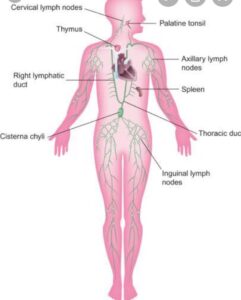
Lymphatic vessels, which carry lymph (fluid) and white cells.
Lymph nodes are concentrations of nodes in the body that fight pathogens (bacteria/viruses.)
Lymphocytes are the cells of the lymphatic system that fight the pathogens.
Spleen produces lymphocytes and filters blood.
Thymus is where the maturation of T cells occurs.
Bone marrow is where the maturation of B cells takes place.
Tonsils, adenoids, appendix, and Peyer’s patches (intestines)
How is the modern world affecting our Lymphatic system negatively? First of all lets remember the lymphatic system is the sewerage system of the body; what our body produces to carry out the waste. However, unlike the vascular system, which pumps the blood to the heart, the lymphatic system does not have its own pump, so therefore we need to take control and do it ourselves.
The main things that affect our lymphatic system are not breathing deeply into our diaphragm, so what we need to explore is learning diaphragmatic breathing and making sure we are practicing this daily; so it can become an unconscious habit and new way of life. We can do this by putting our hands on our ribs so we can physically feel our ribcage expanding by our breath. Humans are usually operating from a shallow breath, so it is so important that we consciously check in with bodies and ourselves. This gives us time to pause, allowing us to be in the present moment by breathing deeply and re-center our being. Diaphragmatic breathing can be an incredibly grounding, peaceful experience and is a vital part of healing.
We spend a lot of time sitting and living inactive lifestyles so movement is very important. Looking back into our past evolution of being human we were designed to walk and survive; this was our purpose and lymphatic problems did not exist. However, because we are not moving a lot due to our jobs and lifestyle our lymphatic circulation doesn’t flow effortlessly which is an issue.
Toxins and chemicals are a lot more common today due to the pollution in our environment, due to synthetic substances. Which can overburden the lymphatic system, especially the liver.
Unhealthy diet (processed foods) creates more stress and toxins in our body. Organic foods would be ideal as they contain fewer toxins and grown in a better natural environment; (soil and air quality.) However, it is not always affordable, and even if some foods claim to be organic, we often don’t know if that’s true — and pollution is still affecting the air quality even if farmers do everything in their hands to avoid toxins in our food.
Digestive imbalances affect the lymphatic system as they work closely together, basically hand in hand if one isn’t working properly then the other system will be affected.
Stress creates stagnation in our bodies at a physical, emotional, and energetic level. This can affect pain.
Dehydration people may not be drinking as much water as they need. This helps flush our the “bad stuff” out of the body, but not only it’s about the quantity but about the quality too. A lot of the water we drink is not ideal and can create “further damage”. This is not to freak you out, but do be mindful of the water you consume. If you have access to Kangen water that’s ideal, however if that’s not possible, use filtered water and just add a few drops of fulvic acid to it to structure it.
“Cells are as healthy as the environment they live in.”
The lymph is responsible and determines this. The healthy cell will not let toxins trespass. The good nutrients stays and the toxins are rejected. Whereas with unhealthy cells, the toxins stay stuck unable to be released, therefore the healthy nutrients cannot be received.
The lymphatic system needs two things, Oxygen and Nutrients. Once the toxicity has been built up in our bodies we need to drain it before we can add the nutrients back in, otherwise it won’t make any difference. So, what causes disease? Two main things, Toxicity and Deficiency. If there is a toxic build up, we are clear that this is not good for our bodies, moreover, the inflammation compresses the nerve causing pain. But if our bodies cannot access oxygen and nutrients, that causes illness too. So when there is constriction, the tissue is not receiving everything it needs in order to be healthy, that’s why in many women with vulvodynia, we find thinning of the vulvar tissue. In order for this tissue to repair, there needs to be irrigation, and for this, first we need to release the built up toxic load.
The Lymphatic System and Digestive System go hand in hand
It is very important to keep these 2 things in mind because sometimes we may be taking great (and pricy!) supplements, but it feels like it’s not making a difference. Your body may not be able to use it because there’s a build up of waste that is not enabling the nutrients to be absorbed. The Lymphatic System and the Digestive system are very tightly linked, so if there is a lymphatic system problem, there is a digestive system problem, and viceversa. Therefore, we need to get rid of the “bad” stuff before we can put the good stuff in.
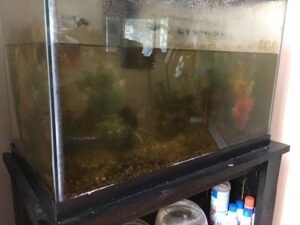
You can imagine a dirty aquarium, where fishes are becoming ill. It doesn’t matter if you give the fish all the “organic food fish” in the market (I am not even sure if there’s organic food for fishes, but you get my point!), the fish will still be ill because of all the dirt. Therefore we need to clean the aquarium, and when we feed the fish, it will thrive. For this reason, we say that “drainage precedes supply”.
Now, how do we know if we have a lymphatic system problem? It is actually quite common to have a backed up lymphatic system as chemicals, toxins surround us and there is pollution in our everyday lives, but I’ll share some of the most common symptoms.
- Morning stiffness
- Bloating or swelling (face, belly, extremities)
- Painful or tender lymph nodes which appear swollen
- Chronic pain (vulvodynia swelling lymph nodes in the groin area.)
- Lack of energy/chronic fatigue
- Skin issues
- Poor sleep
- Inability to lose weight
- Delayed onset allergies
- Easy bruising
- Red/grey eyes
- Low mineral absorption
- Digestive problems
- Bad breath even when you brush your teeth
- Sore breasts and swelling during the menstrual cycle ( psst massaging the breasts to keep everything flowing would be beneficial)
- Common colds
- Ear and respiratory infections
- Sinusitis
- Generalized joint pain/ chronically swollen joints
- Toxic conditions associated with the bowel
- Unresolved trauma which is slow to heal
- Tissue which is tender to the touch
- Tonsillitis
- Nerve pain
- Brain fog/headaches
The lymphatic system is not only a “physical” issue though, it accumulates physical and chemical toxins, yes, but it’s also a dump spot for emotional toxins. The cisterna chyli is the biggest lymph node of the body, located a couple of inches below the sternum and a major emotional spot of the body. A lot of emotions get stored there such as anger, rage and grief. Once we start working on this area, a lot of things may come up and old emotions can resurface; depending on how attuned you are to your body. This can be confronting if we have spent a lot of time dissociating from our emotions and bodies.
The Emotional Patterns and Wounds
The umbilicus is not only a portal to access our gut-associated-lymphoid-tissue, but it is also strongly linked to worthiness, as it is how we got our needs met whilst in the womb. But life happens and sometimes our needs are not met which can create a lack of safety, trauma in the body and a dysregulated nervous system. We may deal with this through coping mechanisms such as self-denial (not being aware of your own needs), deviance (wanting to feed your needs in any way, such as over-eating) and self-reliance (not asking for help to not be let down).
This difficulty to recognize our own needs, or the inability to meet them, can lead to people-pleasing tendencies, which often plays against us. These wounds throw the system off, directly affecting our neuroendocrine system. Often, illnesses that occur in the body without a clear external agent, are correlated to a lack of balance in the body. Our neuroendocrine system is overworked, and mechanisms that are very helpful for our survival and in case of acute illness, they start to play against us overtime. For this reason, when we suffer from vulvodynia we don’t want to only focus on the pelvic floor, but we aim to bring homeostasis into our systems so our whole body can improve. And, as a result, the pain can go away.

Everything Works Together, Mind & Body are One
As we see, nothing in the body is truly isolated. All systems work together and that’s why for a long-term, sustainable healing, we need to approach the body as a whole ecosystem. No system in the body works alone, gets injured alone, or heals alone, and this is why we can fall short when we focus only on the symptom (vulvar pain) and tackle only this area. Our bodies know how to heal when they have the right conditions. Of course, we don’t live in an ideal world, and sometimes we need to work with what we have, but ideally, we can provide the best situation possible for your mind and body to enter the repair mode. I help women heal from this by approaching psychology, nervous system, sexuality, biomechanics, inflammation, and endocrinology (balancing hormones).
Don’t Go After the Pain, Tackle the Root
In short, does vulvodynia go away? Yes, if we address the root cause, improving the whole body health, instead of going after the pain. When pain starts, it means other systems aren’t working properly either, whether we can see it or not. Once the pain starts, it just means that the body has been in survival mode for so long, that it can no longer repair itself, and therefore, it “sacrifices” some of the lesser needed systems, in order to continue protecting the most important ones (such as the heart, the brain, the lungs..). While vulvodynia can be primed by sexual trauma, it is not always the case. However, whether there is that component or not, in all cases we want to restore the safety in your nervous system so your body can continue to repair itself, and we can nurture it in ways that will boost your health and your own inner healing.
What can you do from here?
I hope this helps you gain more clarity on what happens in the body and why it is important to have a multifocal approach to heal from vulvodynia. If it is something that is in alignment for you and that you find interesting, you can book a discovery call with me. Whatever your next steps are, I am wishing you lots of love and healing.
Kindly, Miriam


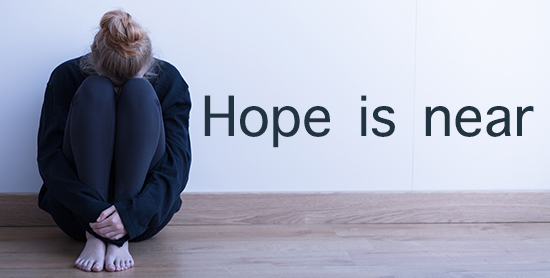
 Complete this form to send me a message. Everything submitted through this form is fully confidential and I will reach back out to you promptly.
Complete this form to send me a message. Everything submitted through this form is fully confidential and I will reach back out to you promptly.